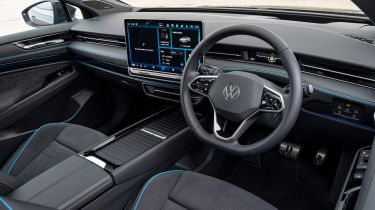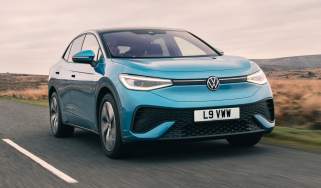Volkswagen ID.7 review - Interior & comfort
“The Volkswagen ID.7’s interior is a little clinical and dull, but feels well-built”
The standout impression of the Volkswagen ID.7’s interior is one of good build quality. Everything feels very well put together, although it does feel a little clinical and uninteresting to spend time in. While both are fairly minimalist, the dash feels conservative compared to the Tesla Model 3, while the Hyundai Ioniq 6 has more going on, if that’s more to your taste.
The ID.7 is a comfortable car to ride in, with the brand’s latest ‘ergoPremium’ seats coming with functions such as a massage feature, ventilation and heating, all of which can be operated via the infotainment screen – though naturally we’d rather this be controlled via physical buttons. Even the air vent control is accessed via a submenu in the infotainment, rather than being an easy-to-use manual slider, which just seems like an unnecessary overcomplication.
Is the Volkswagen ID.7 infotainment and navigation system easy to use?
The ID.7 gets two displays: one 15-inch touchscreen sitting in the middle of the dash through which most of the car’s functionality can be accessed, and a small digital gauge cluster ahead of the driver. The digital display is fairly simple and shows the most important information to the driver. There’s also a head-up display, but it can be quite distracting unless the virtual reality feature is turned off.
More reviews
The climate control can be controlled via a horizontal strip that sits below the screen. After many drivers’ gripes about the lack of backlighting on this panel in the ID.3, Volkswagen has rectified this issue, so now it’s visible even in the dark. The ID.7 still has frustrating touch controls on the steering wheel as in previous ID. cars, but with Volkswagen having pledged to back-track on some of these less-than-intuitive features, we hope they might get replaced with real buttons in future.
As with other ID. cars, Volkswagen forgoes many physical switches in favour of virtual controls through the infotainment system – even the direction of airflow from the climate control is adjusted through this system, and can even be tweaked via the Volkswagen IDA voice control assistant.
The infotainment system is at least fairly easy to use, with intuitive submenus which make it easy to access most features. A minor complaint is the way the strip of shortcuts for maps, entertainment and drive modes has them all arranged close together at the top of the screen – it means you have to take your eye off the road and concentrate too hard while driving to access them. These could do with physical shortcut buttons you could feel for, rather than having to prod blindly at the screen.
Is the Volkswagen ID.7 well equipped?
Trim levels are currently Pro Match, Pro S Match and GTX, so there’s no such thing as a truly entry-level or bare bones ID.7 and every version costs north of £50k. From the off you get 19-inch alloy wheels, a 15-inch infotainment display and an augmented reality head-up display. A powered tailgate and adaptive headlights are standard too. In fact, the Pro S Match doesn’t really get any extra kit, just a bigger battery for extra range.
The GTX gets a sporty makeover and 20-inch ‘Skagen’ alloy wheels, along with a 12-speaker Harman Kardon stereo, ventilated front seats (a massage function is standard across the range), heated rear seats and adaptive suspension.
What options should you choose on the Volkswagen ID.7?
A key option to consider is a heat pump, which costs just over £1,000. This makes heating the battery and cabin more efficient in winter, reducing their impact on driving range, but considering the ID.7’s steep price we’d have preferred this to have been standard. A three-pin plug compatible cable is around £200. Match trim buyers can also add an adaptive chassis setup, illuminated badge, electric tailgate and progressive steering for £1,000. Upgrading to the Harman Kardon stereo, comfort heated front and rear seats, 30-colour ambient lighting and ventilated front seats costs a further £2,000.
Key features | |
|
Match
|
GTX (Match plus…)
|

















